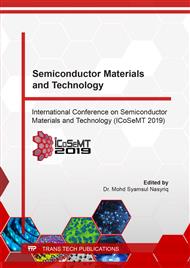p.43
p.52
p.60
p.69
p.77
p.87
p.97
p.103
p.111
Chromaticity Properties of Curcuminoids Dye Nanofibers Prepared by Electrospinning for White Light Down-Conversion
Abstract:
In this study, the chromaticity properties of curcuminoids nanofibers were studied. Recent studies revealed that the nature of emitted light from curcuminoids and the poor stability which limits their illumination applications can be further improved using nanofibers and nanoparticles of curcuminoids. Motivated by this idea, we prepared some Poly(methyl methacrylate) (PMMA) integrated curcuminoids nanofibers via electrospinning. Poly(methyl methacrylate) (PMMA) were used in three types of concentration (5,10 and15wt%) which were mixed with (curcuma longa L.) powder to produce curcuminoids solution by using the centrifuge to separate the curcuminoids solution from the impurities. Different amounts of polymer solution mixed with curcuminoids (1 to 5ml) were spun by electrospinning to study its properties. The effect of annealing on samples was studied. The chromatic study of the samples and the effect of the amount and concentration of the solution were studied by pumping the samples in three different light emitting diode (LED) wavelengths (365, 390 and 445nm). The white light chromaticity coordinates (CIE), correlated color temperature (CCT) and color rendering index (CRI) were measured. The optimum CIE, CRI and CCT values of (X= 0.3051; Y= 0.3370), 64 and 6809K, respectively were obtained. By using field emission scanning electron microscope (FESEM) device, the curcuminoids nanofibers diameter was measured, where the values obtained ranged between 191 to 234nm. After the annealing process, curcuminoids nanoparticles average diameter 13-19 nm were obtained.
Info:
Periodical:
Pages:
77-84
Citation:
Online since:
March 2020
Keywords:
Price:
Сopyright:
© 2020 Trans Tech Publications Ltd. All Rights Reserved
Share:
Citation:


